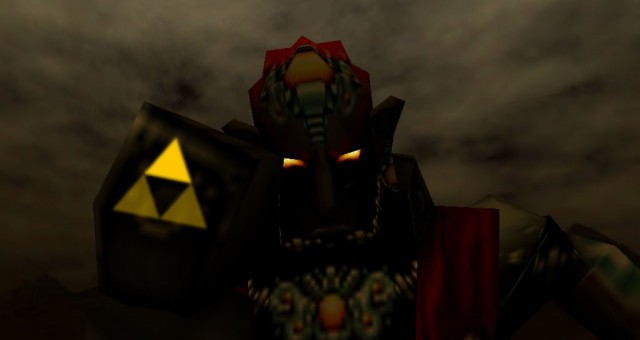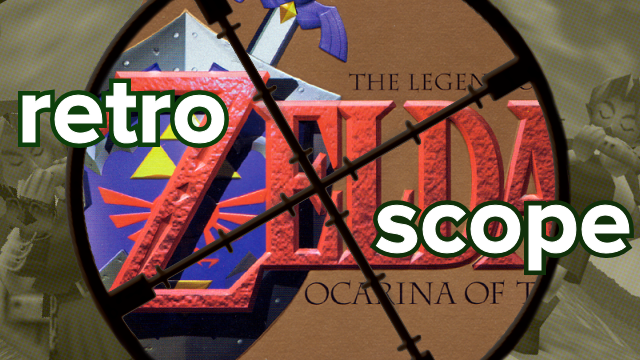When I first played The Legend of Zelda: Ocarina of Time, I was twelve years old and knew that there was no way I was going to beat the game. It was because of the spiders, or to be more accurate, the man-sized arachnids dangling from the ceiling called Skulltullas. I had been anticipating Ocarina for months, scanning every issue of Nintendo Power for whatever details and tidbits I could find. Images of Link standing in clear water on a sandy shore, firing arrows at Poes in a dark forest, and countless other gameplay peeks had me convinced this game was going to be something special. Yet there I was, confronted with my worst phobia and arrested with fear.
Necessity is the mother of invention, though, and preteen Robert had a plan; music. In order to get past the horrors of the Deku Tree, I played the Depeche Mode album Violator to wash away my apprehension and slice apart every spider and sentient shrub in my path. To this day, in my mind the sounds of Personal Jesus and Halo are pleasantly juxtaposed with images of Hyrule Field and Kokiri Forest. I’m thankful I was able to overcome my weakness, as Ocarina remains not just a milestone gaming moment in my life, but also a defining one for me as a person. Ocarina made me realize that video games were capable of more depth than anyone knew, and that I wanted to be a part of this incredible medium of entertainment in some way. People don’t lavish praise on Ocarina out of obligation, they do so because it’s one of the greatest games ever made.
I decided to replay Ocarina the proper way this past weekend, so I dug my Nintendo 64 out of the closet and plugged in my trusty gold copy of the game. There are a few differences between first-run copies of Ocarina and all later re-releases that some people might not know about. The most noticeable are the original Gerudo symbol (a crescent moon with a star at the center) and a different piece of music in the Fire Temple (chanting was a big part of the score). Nintendo, ever cautious to avoid controversy, decided to alter both the symbol and music because they were too evocative of Middle Eastern culture and might have caused some to consider their use disrespectful. Seeing each element of the game as they were originally intended was refreshing. I’d also like to point out how much better Ocarina plays with the N64 controller; the GameCube and Virtual Console ports never made any compensation for the improved analogue sticks of their respective system’s controllers, so aiming was always a twitchier affair than it was ever meant to be. If you want an experience as smooth and responsive as Ocarina of Time 3D, play it on N64!

I take exception to the notion that Nintendo ever intended for Ocarina to look anything less than photorealistic. In a 1998 interview, Zelda creator Shigeru Miyamoto said that one of the goals in developing Ocarina was to “create a totally realistic atmosphere,” something that is clear when taking in the game’s lighting and graphics. When Ocarina finally flashed across TV screens, it was one of the most stunning recreations of the outside world that I’d ever seen. The sun set in a riot of pink, water was translucent and shimmering, and Castle Town (pre-rendered as it was) looked like a picture. Playing Ocarina now is a bit fuzzier-looking than I’m used used to, but part of how I appreciate an older game like this is to think of the moment when it came out. Grasping the inherent technical and creative limitations of that time is key to understanding the vision and accomplishment of a game’s developer. Calling Ocarina ugly or unplayable just because it isn’t in hi-def is like saying silent films are unwatchable because they’re grainy and soundless. Ocarina remains a true visual achievement.
Graphics always pale in comparison to gameplay, and Ocarina is no exception. It shocks me to think of the number of play control innovations ushered in by Ocarina. In 1991, Miyamoto said that during the development of The Legend of Zelda: A Link to the Past, he had wanted to incorporate a feature where the A button could do something different depending on what situation Link found himself in. This context-sensitive control input had to be scrapped when the team couldn’t convey it clearly to players on SNES, but it found new life in Ocarina. From pulling blocks to opening doors, the A button became home to numerous actions throughout Link’s quest. Z-targeting was another important creation, as it provided a solution for focused combat in a 3-dimensional space. By creating a temporary focal point, Miyamoto and company were able to keep the action clear during fighting, but then return the camera to its position behind Link for exploration. That same principle also applies to the first-person use of items like the bow and arrow; adaptable, multiple camera views meant Nintendo didn’t have to commit to just one, and could instead find ways to maximize the use of them all. Those might sound like trivial details, but remember that the development team had no frame of reference for what they were doing outside of Nintendo’s own work with Super Mario 64; like that revolutionary title, much of Ocarina’s controls would end up becoming staples of the industry.
I could go on and on about the quality and fun of Ocarina. Its advances in cinematics, motion capturing, the riveting score, and a thousand other details make it a marquee gaming experience. If nothing else, I just hope that anyone who hasn’t played this game takes the time to finally do so. There are titles that come along once a generation that redefine the medium and set new standards for others to reach. With an aggregate score of 99, Ocarina has remained the number one game of all time on Metacritic for 15 straight years. That’s not a coincidence, but rather a sign of how Ocarina remains a timeless triumph.




 ShareThis
ShareThis








I knew about the things taken out, but I never realized that they were actually released on a cartridge overseas! I’ll have to track one down in the future.
Oh, no, you can play it on an American cartridge. As long as the cartridge is gold and a first or second run (at least a first run for sure) you can see the differences. I got mine that Christmas which was right after it released, so mime is definitely a first run. Be warned-you will see Ganon bleed red, not green!
Ocarina of time STILL is the best game of all time!